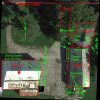I would like to implement a camera system to monitor several areas around my property. Considering that this is a multi-acre rural property, I am not concerned about monitoring the entire driveway and lawn. I am focused mainly on access points to my homes and buildings, especially as I rent out space in one of the barns for boat and camper storage.
I have read the cliff notes but confess that I don’t understand everything I read. I did notice that some of the camera recommendations are about 5 years old so I am not sure what the best current recommendations are. Since I have no practical experience, I was hoping I could get some guidance and recommendation on the camera hardware and placement.
Refer to attached image from google maps.
Goals -
Thanks!
I have read the cliff notes but confess that I don’t understand everything I read. I did notice that some of the camera recommendations are about 5 years old so I am not sure what the best current recommendations are. Since I have no practical experience, I was hoping I could get some guidance and recommendation on the camera hardware and placement.
Refer to attached image from google maps.
Goals -
- Monitor back door of house. Mount camera on soffit at position A, 8.5 feet high.
- Monitor front door of house and the driveway coming in from the road. People generally pull in from the road, park in this section of driveway, and then walk to the front door. Is it possible to “identify” across the 35 ft span from the far side of the driveway to the front door? I would prefer to mount the camera at position C (on the soffit of Barn 1, 14 feet high) but I wonder if position B (house soffit, 9 feet high) is better? Distance to door is 30 feet if mounted at C but only 22 feet if mounted at B.
- Monitor 28” feet of driveway along Barn 2 and the 53’ door section on Barn 2. I was thinking this would be done with 2 cameras mounted on soffit of Barn 1 at positions D and E. But maybe a camera at point G would also be useful? The problem with location G is that it will be difficult to get network cable to this area.
- Monitor garage doors and the area in front of them on the west side of barn 1. Maybe from a second camera mounted at position E?
- Monitor overhead door and entry door on south end of barn 1 by a camera mounted on soffit at position F, 11 feet high.
Thanks!


